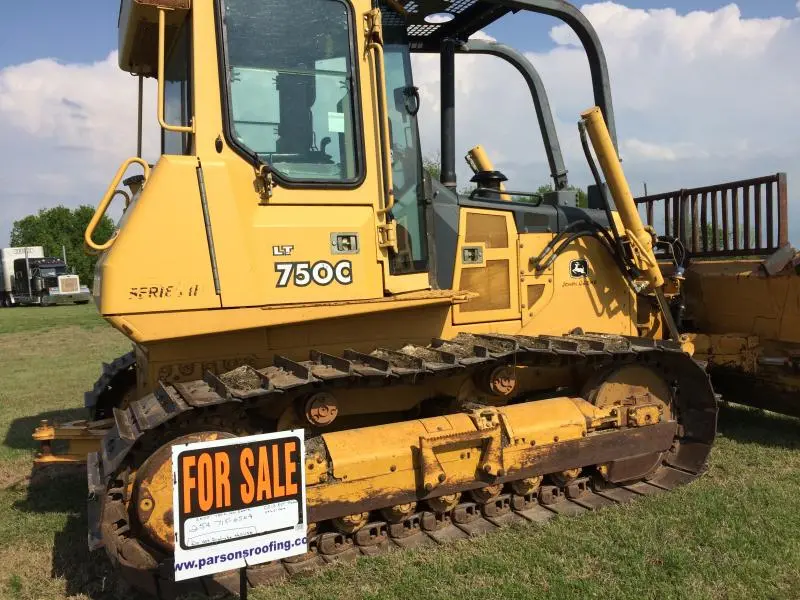doesn't have a transmission, haws two variable displacemnt hydraulic pumps(one for each side) and two variable displacement hydraulic motors (one for each side) that provide the drive. they were good units, biggest problem was mistracking (not driving straight) but can be adjusted during the calibration process. these are not a heavy duty bulldozer, they are designed for trim work, finish grading, if you are looking for bulldozing large volumes of soil it is better to buy one with a bulldozer (not a 6 way PAT) engines are strong and easily can give 20000 hrs with routine maintenance,
overall, units are fairly easy to work on, hardest part is calibrating the hydrostatic system, does take some high pressure guages to do it properly and you have to have ability to measure differential pressure at high pressures, OTC made a digital guage that could have up to 4 inputs that we used at the dealer when calibrating the hydrostatic drive system. there was also some upgrades to the units over the years, the series three upgrade was a refinement and was really good improvement over the series one and two units. it provided more variable drive speeds to match the working conditions over the previous "gear" 1,2 or 3 levels as the series one and two units had.
the operations and test manual is a critical book if owning one of these machines, Deere did an excellent job on these books and made them very easy to understand. you could not skip a step in their diagnostic section or you would end up going don the wrong path.
series three had a lot of the bugs worked out. if you can get a sample of the hydrostatic system fluid analyzed that would also be good.
if the machine "jumps" when you release the park brake then one of the pumps is not returning to "zero" or neutral position, sometimes can be calibrated out. maintenance of the hydrostatic system fluid was the cheapest and easiest maintenance on these units.
the pumps and motors were not terribly expensive to overhaul. when we overhauled them, they needed very little for parts, a seal kit and maybe the swashplate bearing cage. sometimes we would get the rotating group slippers lapped, but that was generally after a significant system failure where there was metal floating in the system. Course it has been 15 years since i was at the dealer and we were installing the series three updates into the series two units. if the hydrostatic fluid was properly maintained the pumps and motors would last about 20000 hrs. we always ran the low viscosity hygard oil because it gets cold up here. some of our customers insisted that we use 0w40 plus 50 oil in every compartment, so when we did the PDI on the unit we would swap out all oils in all compartments for 0w40, we didn't see any significant impact to the durability or reliability of the crawlers or excavators by doing this. it made it simpler for their operators and mechanics as there was only one oil to be used in all of the machines that company owned.
those units were designed to be run at wide open throttle all the time, if the engine wasn't revved up they seemed sluggish, quite different then operating a traditional steering clutch powershift or driect drive unit.
there ability to counter-rotate and push while turning maintaining positive drive to both tracks made them ideal for finishing grade work.
can someone tell me how to post a picture? I have one of the JD750C that I am looking at.
can someone tell me how to post a picture? I have one of the JD750C that I am looking at.
You have a wonderful day. Best wishes. Deas Plant.
Hi, Dick Tucker.
Scroll odwn from the 'Reply' window to the second panel down and you will find a button labelled, "Upload Photos". Click on that and it should bring up the photo selection panel. Select 'Add files" and then 'Browse', find the folder and then the photo file that you want to upload, select that file and then select 'Upload File'. When the file has uploaded as indicated by the extending red line, a thumbnail of the photo will appear in a panel a little lower down. Select the 'Insert Inline' button and your photo(s) should be in your reply.
I always try to remember to select 'Preview Post' before actually submitting the message to make sure that the photo is actually there by clicking on the the thumbnail in the preview.
Just my 0.02. Hope it helps.

series 2 machines were good machines, i did not mean to mislead you by saying "they had bugs worked out" myintention was to indicate that the series three was a little more refined in the control of the hydrostatic drive. most parts are interchangeable between the series 1, 2 and 3 machines. no major parts were changed or upgraded, just the control lever for the hydrostatic drive in the cab.
from the picture, it looks like a tidy machine, all the ones i worked on were either rear mount ripper or winch cats, so i do not know if the machine is well balanced with a hitch on it, can't say i've ever seen one with a hitch except for when we accepted a factory delivery and then installed a winch or ripper as per the customer order.
I personally liked working on the units, and i liked operating them. My buddy runs dozers full time, he likes the deere creature comforts and drive controls, he does say that the equivalent caterpillar product rides smoother, ie the d6r's ride nicer than the 750c and 750j machines ( not an exact crossover as the six is slightly different in size and weight comparison)